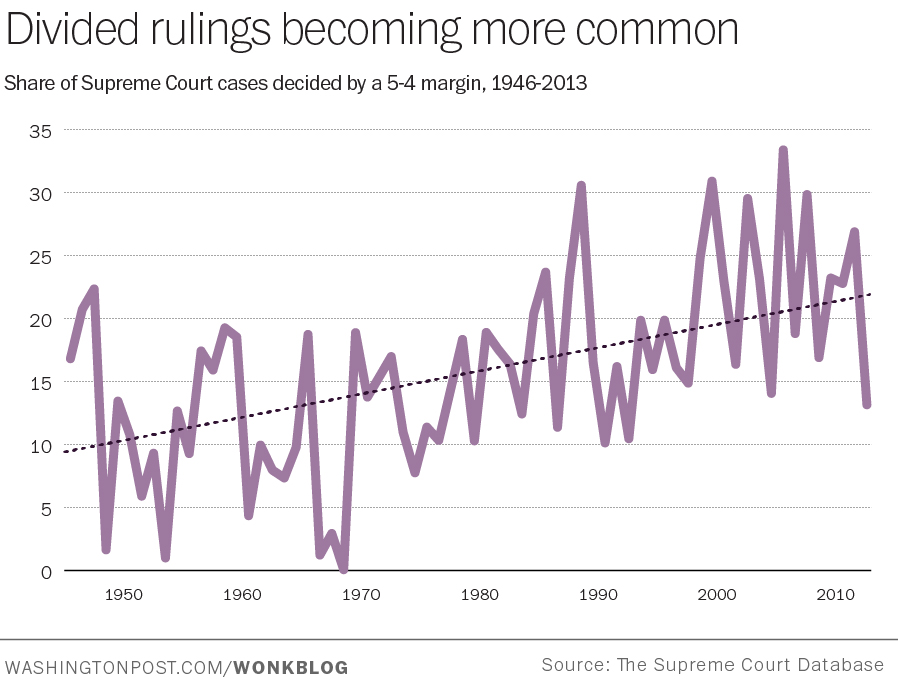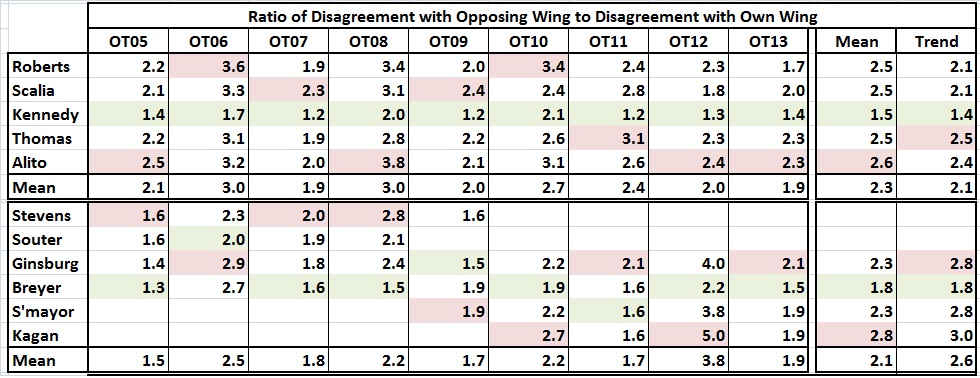Christopher Ingraham, a contributor to The Washington Post’s Wonkblog points with alarm at the increasing frequency of 5-4 decisions by the U.S. Supreme Court:
 What does Ingraham make of the graph?
What does Ingraham make of the graph?
These numbers show that the political polarization that has gridlocked Congress and divided the American public has also made its way into the halls of the nation’s highest legal authority.
Ah, gridlock, the bane of “liberals,” who want no impediment to the growth of the central government’s already vast power. Too much power isn’t enough for a “liberal.”
In fact, if you look carefully at the graph — and ignore the spurious trend line — you’ll see no discernible trend until the 1980s. It was only then that conservatives (staunch and wavering) began to replace Democrat appointees and Eisenhower’s RINOs. Nixon’s appointees Warren E. Burger (1969 – 1986), Lewis F. Powell (1972 – 1987), and William H. Rehnquist (1972 – 2005) were joined by Reagan’s appointees Sandra Day O’Connor (1981 – 2006) and Antonin Scalia (1986 – ). Subsequently, Anthony M. Kennedy (1988 – ) replaced Powell (a wash); David H. Souter (1990 – 2009) replaced William J. Brennan (a wash); Clarence Thomas (1991 – ) replaced Thurgood Marshall (a big plus); Ruth B. Ginsburg (1993 – ) replaced Byron R. White (a minus); Stephen G. Breyer (1994 – ) replaced Harry A. Blackmun (a wash); John G. Roberts (2005 – ) replaced Rehnquist (a wash); Samuel A. Alito (2006 – ) replaced O’Connor (a big plus); Sonia Sotomayor (2009 – ) replaced Souter (a slight minus); and Elena Kagan replaced John Paul Stevens (a wash). (Source: “U.S. Supreme Court: Lines of Succession.”)
In sum, the Court began to lean right in the 1980s, and has gradually leaned a bit more to the right, thanks mainly to the addition of Thomas, Roberts (despite the Obamacare decision), and Alito — and no thanks to the four Clinton-Obama appointees (Ginsburg, Breyer, Sotomayor, and Kagan). This tilt caused a rising trend of 5-4 decisions from the 1980s to the present. Some of those decisions were pro-liberty; some of them were pro-license and pro-government. But a 5-4 pro-liberty decision is better than any kind of anti-liberty decision. So, I’m thankful for “gridlock” on the Court, and Ingraham and his ilk would be, too, if they weren’t mindless parrots.
What’s in store for the Court? The recent past holds come clues. I begin with the Court’s first nine terms with Roberts as Chief Justice. (Each term begins on the first Monday in October, and is known by the year in which it starts. Thus Roberts’s first term was October Term 2005, or OT05. The current term, and ninth for Roberts, which won’t end officially until the day before the first Monday in October 2014, is OT13. See Rule 3, here.)
The following analysis begins with statistics that I devised five years ago. Here’s how I described the statistics, taking Justice Alito’s record in the non-unanimous cases of OT08 as an example:
Alito … was in disagreement with his four “allies” (in non-unanimous cases) a total of 72 percent of the time …, for an average of 18 percent per ally. Alito was in disagreement with his four “opponents” a total of 272 percent of the time, for an average of 68 percent per opponent.
(The use of non-unanimous cases highlights the degree of disagreement among justices, which would be blurred if all cases were included in the analysis.)
The percentages for Alito yield a ratio of 3.8 (68 percent divided by 18 percent). In other words, on average, Alito disagreed with members of the “liberal” wing 3.8 times more frequently than he disagreed with members of his own “conservative” wing. Similarly, in the same term, Justice Breyer disagreed with members of the “conservative” wing in 44 percent of non-unanimous cases, while he agreed with members of his own “liberal” wing in 30 percent of non-unanimous cases, for a ratio of 1.5.
The following table summarizes the ratios for each justice in each term. Justices are grouped by wing and then listed in order of seniority (the Chief is always first, by virtue of his office). Pale green and pale red shadings indicate the most “agreeable” and most “disagreeable” ratios for each wing and each term. Trends are simple linear estimates of each justice’s performance in OT14, given his or her record in preceding years.

Derived from statistics reported and archived by SCOTUSblog. Specific sources are listed at the bottom of this post. Justice O’Connor’s truncated participation in OT06 is omitted.
The year-to-year variation in mean ratios suggests that some terms are more fraught with ideologically divisive cases than others. I normalized the year-to-year results by dividing each justice’s ratio for each year by the mean ratio for that justice’s wing. The following table gives the normalized ratios:

The numbers should be unsurprising to anyone who follows the Court’s rulings. Kennedy and Breyer are the moderates of their respective wings; Scalia, Thomas, Alito, Ginsburg, Sotomayor, and Kagan are the firebrands of their respective wings. Roberts and Scalia seem to be moving to a slightly different beat than their conservative confreres, but neither justice seems to be on the verge of desertion from the conservative wing.
How long might the current balance remain in effect? Consider the justices’ ages:

Ginsburg insists that she has no plans to retire. If that’s true, and if she doesn’t retire before the end of Obama’s presidency, she may be replaced by a Republican appointee. (Obama’s current deep unpopularity stokes the flame of hope for a GOP-controlled Congress and White House come 2017.) If that were to happen, the Court could swing decisively in a conservative direction. Breyer’s post-Obama retirement would be frosting on the cake.
It would be desirable if Scalia and (especially) Kennedy were to offer themselves up for replacement between 2017 and 2020 or 2024 — if the GOP is in control during those years. After that, who knows what will happen, given the unpredictability of events and the fickleness of the electorate.
The GOP appointees should be relatively young Burkean conservatives, If they are, something resembling the real Constitution might yet arise from the ruins of 20th century jurisprudence.
* * *
Related posts:
The Real Constitution and Civil Disobedience
A Declaration of Independence
First Principles
The Constitution: Original Meaning, Corruption, and Restoration
The Unconstitutionality of the Individual Mandate
Does the Power to Tax Give Congress Unlimited Power?
Does Congress Have the Power to Regulate Inactivity?
A Declaration of Civil Disobedience
Questioning the National Debt
Rethinking the Constitution: “Freedom of Speech, and of the Press”
A Balanced-Budget Amendment and the Constitution
The Repealer
Abortion and the Fourteenth Amendment
Obamacare: Neither Necessary nor Proper
Our Perfect, Perfect Constitution
Constitutional Confusion
Reclaiming Liberty throughout the Land
A New Constitution for a New Republic
Restoring Constitutional Government: The Way Ahead
“We the People” and Big Government
How Libertarians Ought to Think about the Constitution
An Agenda for the GOP
Wrong for the Wrong Reasons
__________
Sources of statistics about disagreements in non-unanimous cases, by term (in ascending chronological order):
Click to access GULCSupCtInstituteFinalReportOT2005_30June06.pdf
http://www.scotusblog.com/archives/SuperStatPack.pdf; http://www.scotusblog.com/wp-content/uploads/2008/06/nonunan07.pdf
Click to access justice-agreement.pdf
Click to access Final-Charts-070710-JA.pdf
Click to access SB_OT10_stat_pack_final.pdf
Click to access SB_agreement_OT11_final.pdf
Click to access agreement_OT12.pdf
